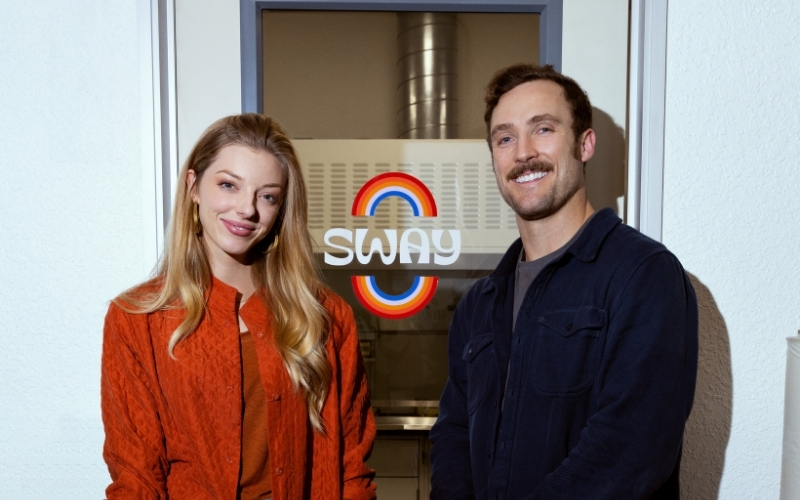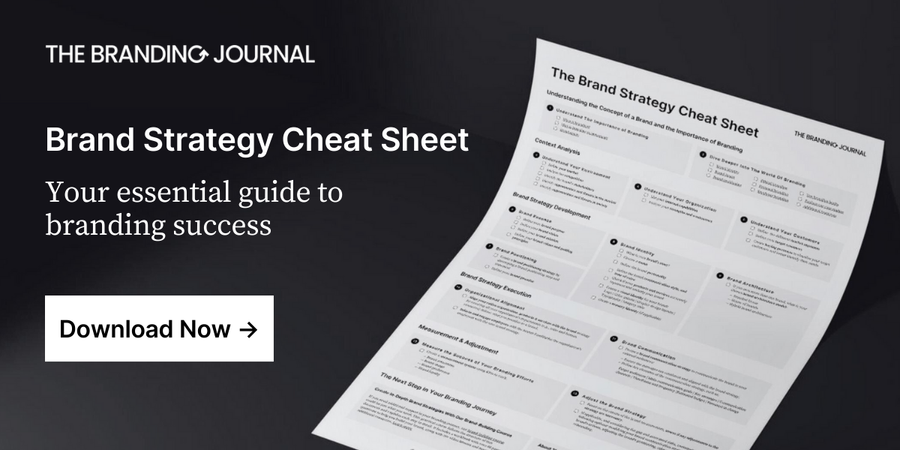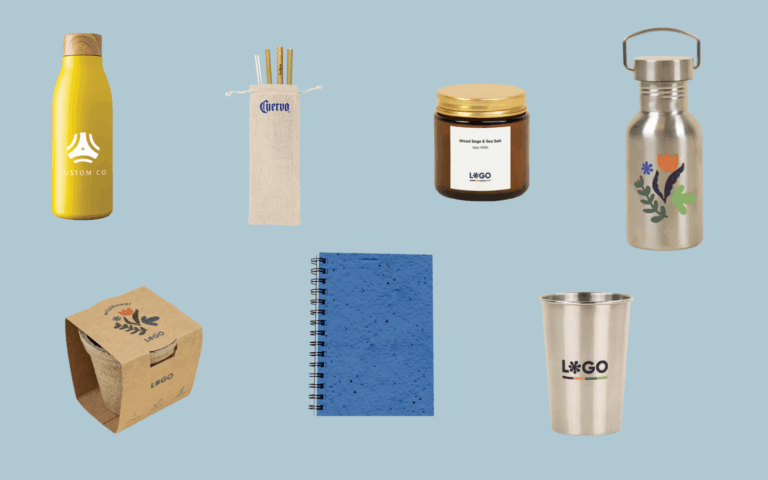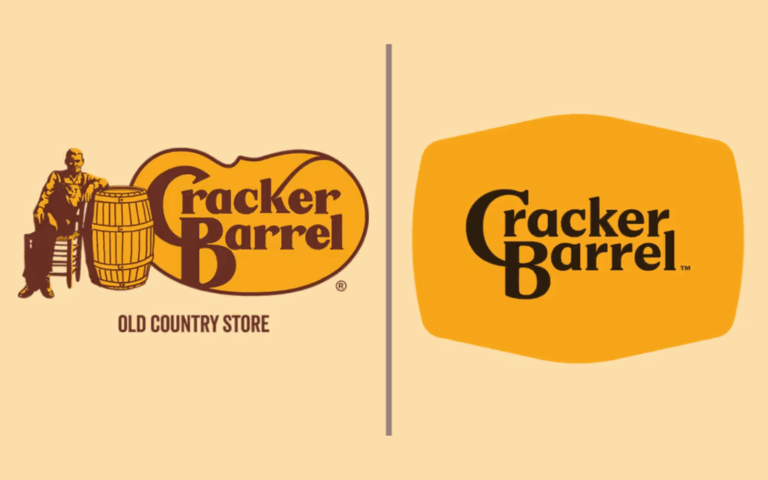In the search for ethical branding case studies, Sway is a B2B brand that caught my attention.
Not only does it have a fun, beautiful, and well-executed B2B brand, but it’s also one of the few businesses that manages to go beyond sustainability and embed the regeneration of nature at the core of its brand’s DNA and actions.
Amidst the dire consequences of plastic waste and climate change, Sway has emerged as a beacon of hope. The brand uses the power of seaweed to create plastic alternatives that not only avoid harm but actively replenish the Earth. With a purpose-driven brand strategy and a deep commitment to regenerating nature, Sway is a beautiful example of an innovative brand working on building a future where people and the planet thrive together.
I hope this case study can inspire entrepreneurs and brand strategists to create better brands and serve as a compelling example of branding at the service of sustainability. In this article, we’ll dive into the world of Sway, exploring their innovative products, inspiring branding journey, and the regenerative way forward.
Proven Systems for Business Owners, Marketers, and Agencies
→ Our mini-course helps you audit and refine an existing brand in 15 days, just 15 minutes a day.
→ The Ultimate Brand Building System is your step-by-step blueprint to building and scaling powerful brands from scratch.
Table of Contents
About the Brand
Sway is a US start-up dedicated to creating seaweed-based, compostable alternatives to plastic, beginning with flexible packaging that matches the performance of traditional plastics.
In 2023, they won the TOM FORD Plastic Innovation Prize, adding to previous accolades like the Beyond the Bag Challenge in 2021.
Diving Into the World of Sway
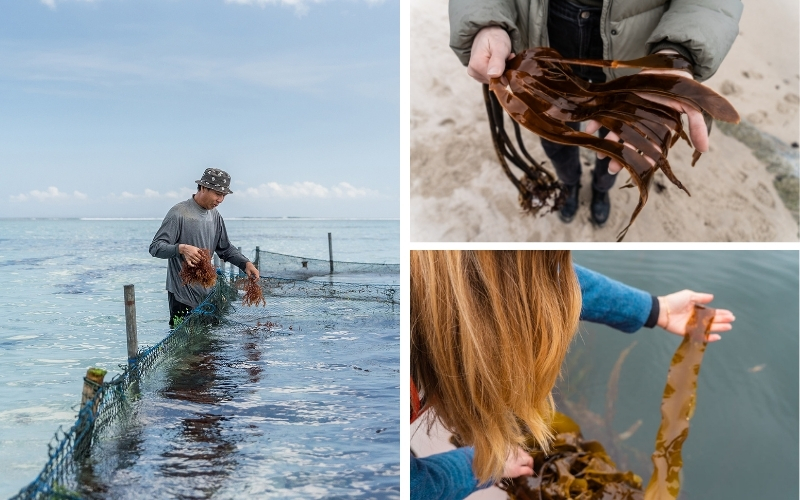
Image Credits: Sway (left), Edges of Earth (top right), Alex Krowiak (bottom right)
Julia, a designer who specialized in creating brand and packaging systems, often found herself introducing plastic into her designs. However, she realized that design could be crucial in facilitating the transition to plastic-free solutions, as she believed plastic waste was ultimately a design flaw.
After conducting a comprehensive evaluation of all available plastic alternatives, Julia discovered that few solutions were truly better across all criteria. Each alternative made compromises in terms of feedstock sustainability, decomposition rate, performance, or cost. She even found that many bioplastics had their own unique set of consequences.
“In my pursuit of solutions, I became obsessed with the third pillar of the circular economy, which asks that we regenerate natural systems. What if replacements for plastic could actually replenish life? Despite my non-technical background, it was clear that there’s a wealth of overlooked potential solutions in nature which embody the concept of regeneration. Mycelium, scoby, microalgae, agricultural waste, seaweed – all these renewable resources can be leveraged into new innovations while giving back to ecosystems as they grow.”
Seaweed, in particular, caught Julia’s attention. Growing up in the Monterey Bay area, she was already well-acquainted with underwater forests and ocean farms. She admired the beauty, diversity, and abundance of seaweed and was intrigued by its rich natural polymer content. Julia researched seaweed’s potential as a feedstock to replace plastics and discovered it met all the necessary criteria. Seaweed grows rapidly, requires minimal carbon-intensive inputs, thrives without fresh water or pesticides, and is readily available along nearly every coastline worldwide.
As the vision for Sway began to take shape, Julia and her co-founder, Matt, embarked on a journey to visit farms and engage with scientists. They drove along the Pan-American Highway from Berkeley to Peru, meeting with seaweed cultivators along the way.
“We found that seaweed farms naturally support improved water chemistry, biodiversity, and coastal communities. New science even suggests seaweed can store massive amounts of carbon.”
This is how Sway was born—an innovative brand redefining how we think about materials and packaging.
A True Purpose-Led Brand Strategy at the Service of Sustainability
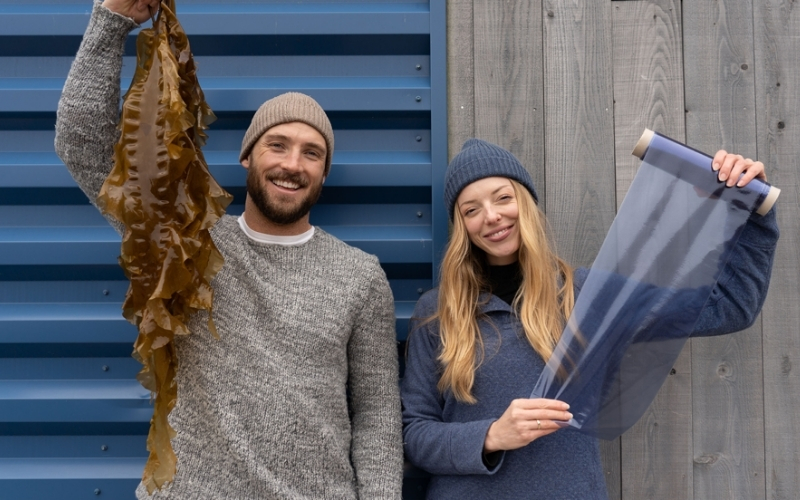
Sway’s brand strategy derives directly from the founders’ beliefs and the brand’s story. This makes it purpose-led and very consistent across all touchpoints.
However, as you will discover, some aspects make the strategy quite unique, especially the brand’s community-focused communication strategy (which started long before the product launch) and the visual identity, which is very different from what we usually see in the B2B world.
These unique elements make Sway a fascinating case study from a brand-building perspective, offering insights for other brands to learn from.
Brand Purpose
Sway’s purpose is to lead the way in regenerative design, creating packaging materials that not only avoid harm but actively restore and replenish the planet.
By prioritizing a conscious process and striving to undo the damage caused by traditional plastics, Sway aims to combat climate change and plastic pollution globally.
“While traditional plastics contribute to climate change at every step of their toxic existence, Sway materials are made with process in mind. We strive to undo the harms of plastic pollution everywhere, from the ocean to your backyard.”
Brand Vision
The brand envisions a world with regeneration as its core, “where we design not simply to avoid harm, but to restore and replenish our aching planet.” This vision drives Sway’s research and development efforts.
Brand Mission
A brand’s mission is its ‘master plan’ to achieve its vision. It describes how the brand aims to conduct daily operations and make decisions to serve its purpose and achieve its vision.
For Sway, it is to embody all three pillars of the circular economy: design out waste, keep materials in use, and regenerate natural systems.
“This methodology is reflected in our product portfolio and throughout our entire value chain. With a holistic approach, we can regenerate social and ecological systems harmed by climate change and plastic pollution.”
Brand Positioning: Standing out in a Sea of Green

In a market increasingly saturated with “sustainable” products, Sway differentiates itself by going beyond sustainability and choosing truly regenerative solutions.
They are innovation-focused and deeply committed to solving the plastic crisis by developing their research on materials. As Julia states, “80% of environmental waste is determined at the design stage. Designers can wield their power and influence to make ‘better’ materials beautiful, accessible, and efficient.”
By positioning itself as a leader in regenerative design, Sway sets itself apart from competitors and appeals to brands and consumers looking for more than “green” products.
Brand Promise
The company promises to design materials that replenish the planet, from sea to soil. This statement is prominently displayed on the brand’s website.
Product Strategy: Pioneering Seaweed Packaging Solutions
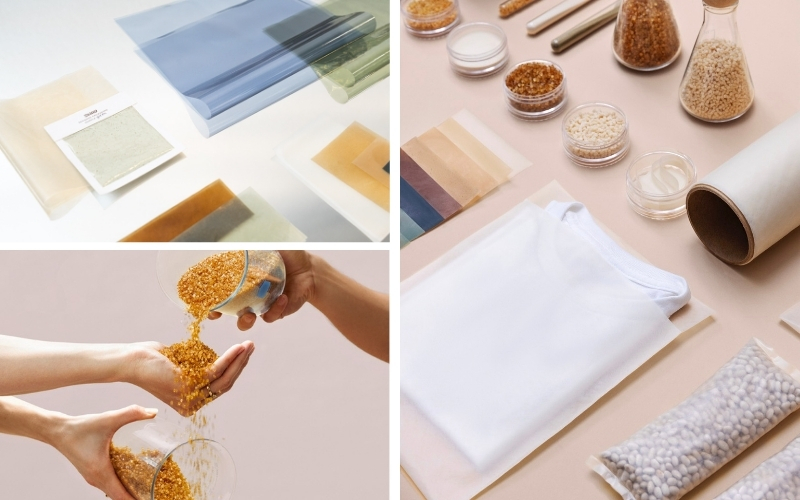
A brand’s products or services are vital in shaping its identity. They embody the brand’s uniqueness, actions, and choices. Sway’s product strategy is a perfect example of products that are fully aligned with the brand’s strategic vision. The products (seaweed packaging) embody the brand’s core principles and effectively fulfill its promise (materials that replenish the planet), which is essential for enhancing the brand’s reputation and nurturing trust within its community.
How are they achieving this? Let’s see in practice.
Product Development Process
After conducting their own research and development, the team has developed a whole range of home-compostable plastic replacement materials made from seaweed. They are designed for various uses and sectors, such as packaging for apparel, household items, beauty products, and food.
Some are available for purchase, and others are being piloted by innovation partners dedicated to evaluating and enhancing their products in development.
The current range of products consists of:
- Seaweed Windows (available for purchase): These 100% biobased seaweed windows are clear, durable, and food-safe. They are derived primarily from seaweed and are certified to decompose in home and industrial compost.
- TPSea™ (available to pilot) 100% renewable seaweed resin, designed to replace plastics
- TPSea Flex™ (available to pilot): Versatile film made with seaweed, built for impact at scale.
- Polybags (available to pilot): Compostable seaweed packaging that looks & feels like luxury.
The Main Material
Seaweed is more than a sustainable raw material—it’s a natural resource with regeneration virtues. “Seaweed is an incredible ocean crop that can purify and clean our seas, enhance underwater biodiversity, and boost coastal economies, securing climate-resilient employment for those most vulnerable to the impacts of our changing planet,” Julia explains. By choosing seaweed, Sway is not only reducing plastic waste but also actively supporting the regeneration of marine ecosystems and the livelihoods of coastal communities.
Sourcing and Post-consumption Considerations
Sway has a strong sourcing strategy in place and carefully designs the products to be able to return to Earth safely after use. Their evolving portfolio of products is:
- Made with responsibly sourced seaweed
- Nontoxic & GMO-free
- Home & industrially compostable
- Supports healthy ecosystems & communities
Brand Identity: Unique for a B2B Company
Building a brand that stands out in the packaging material industry is complex. B2B companies are often very corporate and rarely engage with the broader community.
Sway chose a different approach. The brand has been designed with a unique personality, a certain proximity to the public, and a bold visual identity that stands out in a sea of similar-looking green, sustainable brands.
Brand Name
The name “Sway” conveys the graceful motion of seaweed in the ocean. It represents the product and the brand’s philosophy of adapting and following nature’s cycles.
Brand Values and Personality
The brand is built around the values of sustainability, innovation, and collaboration.
Sway’s brand personality is vibrant, approachable, positive, solutions-oriented, and visionary. This is reflected in their messaging and tone of voice, which are focused on finding solutions to current sustainability challenges through engaging, educational visuals designed to inspire.
Logo and Visual Identity
In March 2022, the company redesigned its logo to better reflect the brand. The redesign includes two versions of the logo (a horizontal one and one composed of the letter “S”). The chosen typography for the “S” logo version, including a 3D-glowing font, is a bold choice that distinguishes it from brands in the packaging and sustainability markets.
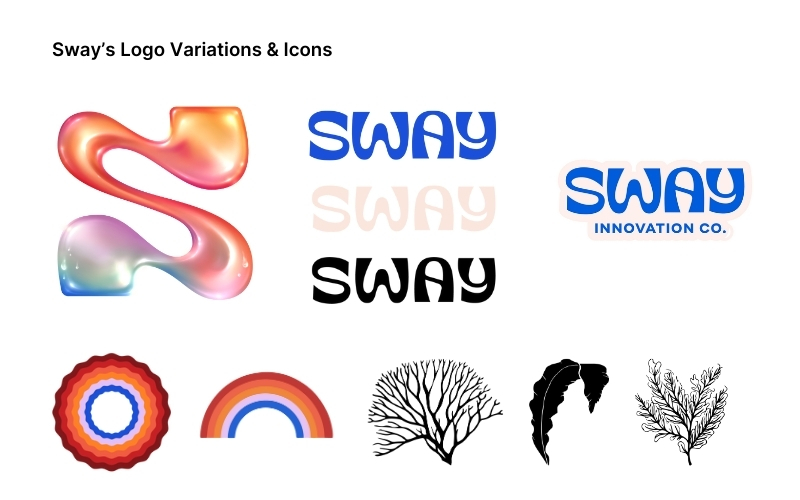
“Sway is blooming. Our team and network are growing, major milestones are just around the corner. We’re getting our sea legs, you could say. Today, we are excited to share that our visual identity is evolving with us. Say hello to our new logo and wordmark!
This evolution is both functional and symbolic. We are a company that aims to blur the lines between nature, technology, and design. We’re firm in our belief that communication and design have a critical role to play in the plastic-free transition. That means we need a bold, easily recognizable mark that can be used on packaging of any size, building trust and recognition among our community.”
The brand sets itself apart with a striking imagery style. The brands uses icons and elements such as seaweed icons, a colorful wheel and a vibrant rainbow.
Sway prioritizes high-quality photography and video production, showing professionalism. On Instagram, their primary social media platform, each post showcases meticulous attention to detail and graphic design, creating a harmonious and colorful blend with surrounding content. The website is also carefully crafted, offering an engaging visual experience reinforcing the brand’s overall aesthetic.
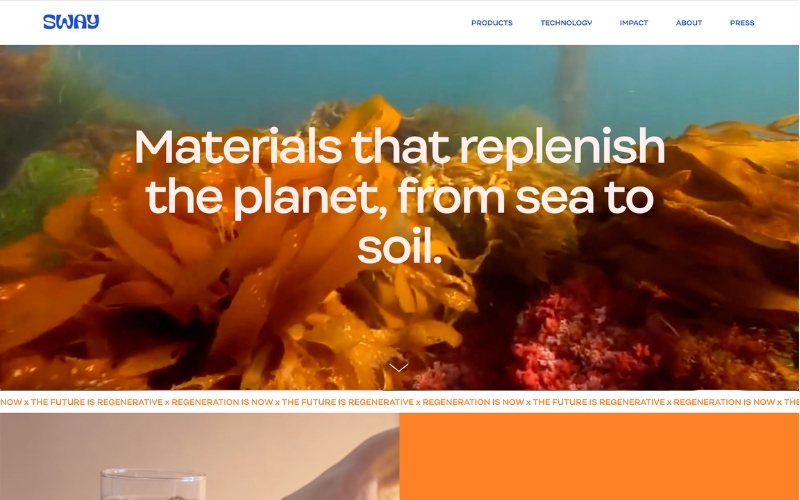
Sway’s Website Homepage. Image Credits: Sway
Last but not least, the chosen color palette is bright and unique within the sustainability movement. The brand uses a gradation of colors ranging from blue to red, orange and violet, recalling the colors of the ocean floor and corals.
“Our new visuals are inspired by the ocean, evoking its primordial currents and the dynamic form of seaweed—one of Earth’s oldest beings. Mirroring the symmetries and fluidities of nature, Sway moves nimbly within industrial systems, transforming dated practices to enable the regenerative futures we can build together.”
Engaging the Public: How Sway Communicates Its Brand
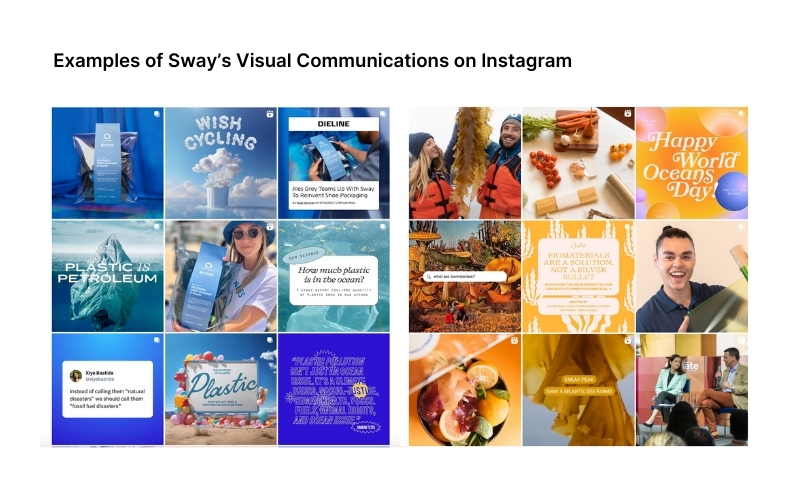
Sway’s brand communication is a masterclass in engaging and inspiring their audience.
Despite being a B2B brand without a final product for several years, Sway has amassed an incredible following on Instagram, with over 130K followers. Through stunning visuals, educational content, and inspiring stories, Sway built an engaged community before the launch of their product by sharing the brand’s story from the very beginning.
“Systems change is only possible with behavior change. If our community understands the value of seaweed, regeneration, ocean health, and circularity, they will go beyond just advocating to their favorite brands that they don’t want plastic. Instead, they’ll have suggestions for how to replace it!” Julia shares.
Today, the brand continues to invite its audience to become part of the solution to plastic waste and climate change. It shares information about its products but also insightful content around sustainability, initiatives from other brands, behind-the-scenes images, and much more.
Their communication strategy is very collaborative, and the founders also represent the brand at events and in interviews, helping the company reach new audiences.
“Once you start to learn about the tangible benefits of seaweed, there are so many other stories to uncover – new science, frontline farmer stories, ocean health, regeneration, circularity, composting, and beyond,” Julia explains. By sharing these stories and engaging their community in meaningful conversations, Sway is building a loyal community and movement of empowered consumers ready to embrace regenerative solutions.
Key Lessons and Practical Take-Aways
To wrap up this case study, here are some practical takeaways and ideas to help you in your brand-building process:
#1 Spend time clarifying your brand’s purpose and vision for the future
Brand strategies are long-term, and establishing a strong brand requires a clear strategy to guide your actions toward future goals. Sway was founded on a distinct purpose shared by its founders, along with a well-defined vision for contributing to a better future. This clarity enabled them to organically develop a company, brand, and products aligned with their forward-looking vision, ensuring that their day-to-day actions and decisions are consistently informed and purposeful.
#2 Explore regeneration practices as part of your brand’s activities
Achieving sustainability is already an excellent priority, but why not take a step further and thoughtfully explore the inclusion of regenerative practices in your brand’s activities? This approach not only encourages you to think outside the box and bring unique, positive solutions to society, but it’s also a way to stand out and position your brand for a future that increasingly demands sustainability. However, it’s essential to ensure that these initiatives are genuine and not just a façade for greenwashing. Remember, no brand is 100% perfect, and every meaningful step toward sustainability and regeneration counts. To start exploring the concept of regeneration, you can explore this resource that highlights various domains where regenerative solutions are possible.
#3 Adopt an engaged community approach
Sway has built an engaged community thanks to educational and inspiring content over its brand-building journey. Consider focusing on creating a community around your brand, be it virtual or non-virtual, and around the concept of a shared purpose and values. Building this connection strengthens loyalty and empowers your audience to contribute to your brand’s vision.
#4 Ensure your products deliver your brand’s promise
Unlike humans, brands often don’t get second chances. Focus on creating products that solve a real problem, truly embody your brand’s strategic vision, and fulfill promises at every consumer touchpoint. This alignment reinforces trust and credibility, showing that your actions match your words.
#5 Stand out and be bold
To build a strong brand, it’s not enough to do better than your competitors, you also need to be different. Don’t be afraid to differentiate your brand with a distinctive identity within your industry. Being unapologetically unique yet professional not only sets you apart but also attracts like-minded individuals who share your universe
#6 Invest in high-quality communication materials
Prioritize high-quality visuals and communication materials from the outset to enhance brand perception and trust. Investing in helpful content and professional presentation signals professionalism and increases the value of your brand in the eyes of consumers.
#7 Collaborate to build a supportive network
Cultivate partnerships that create a network of supporters within the industry and the wider public. Like Sway, you can focus on building a positive and collaborative brand ecosystem for shared growth and innovation. Collaborating with others amplifies your impact and helps you reach your long-term objectives.
Cover Image Credits
- Cover Image: Founders of Sway. Credits: SnackTime




